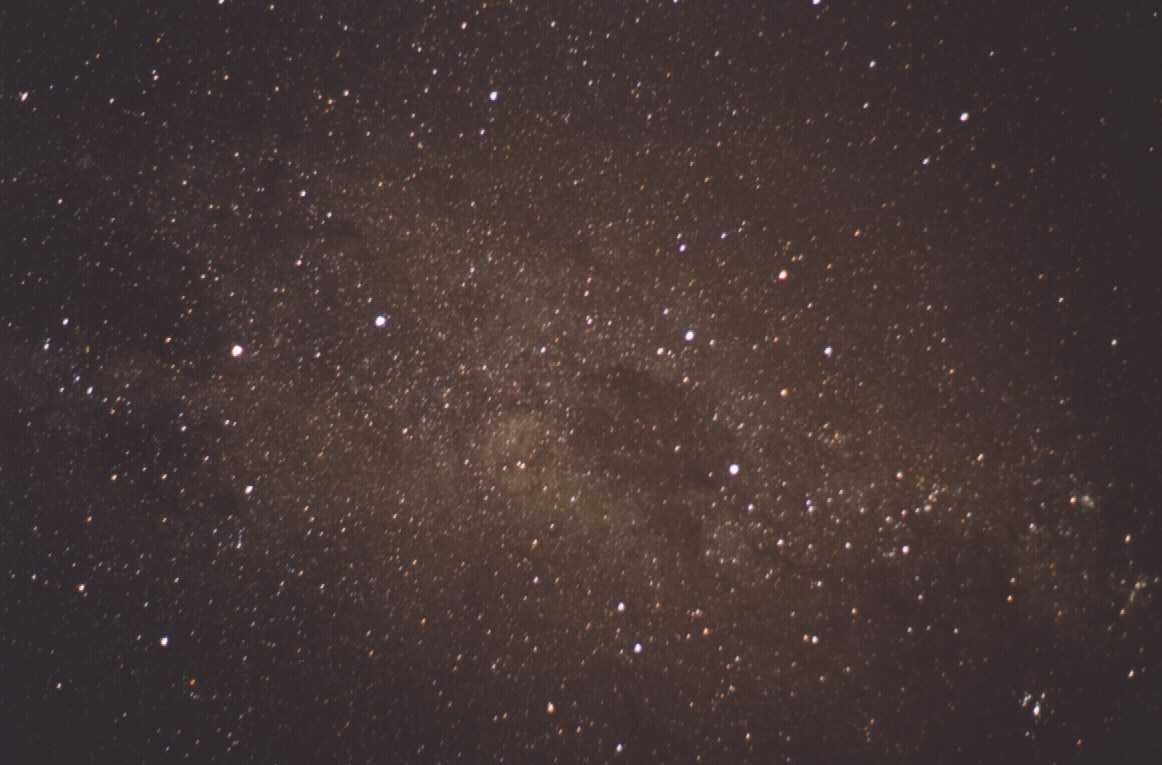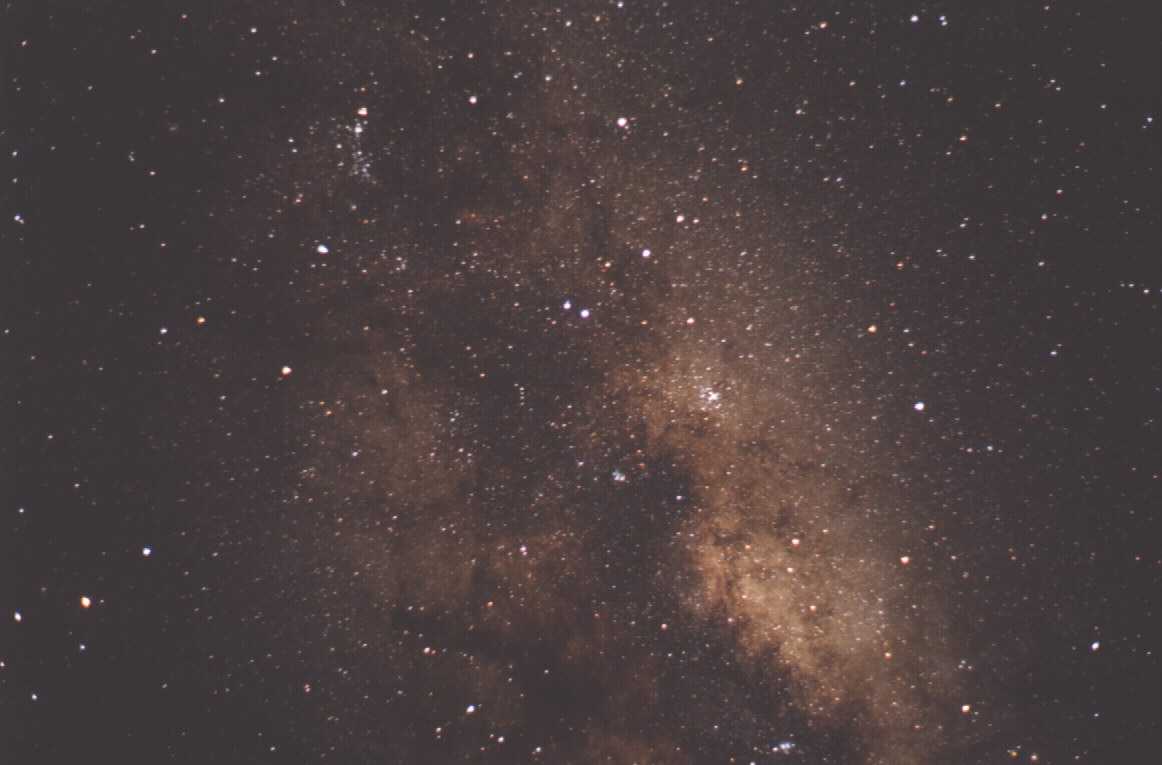
(27° 15' S, 28° 31' E)
An account of Dave Gordon and Dino Fotinidis' astronomy observations at a dark sky venue about 1½ hours drive from a light-polluted Johannesburg. It should be noted that their respective spouses were in attendance and in fine outdoors spirit, however they once again displayed an astronomy attention span of about 4.3 nano-seconds!
We arrived on the deserted farm at about 4.30 in the afternoon, greeted by a stunning sunset. The venue is ideal for astronomy observation; set upon a small hill with no obscuring trees or mountains - 360 degrees of pure bliss. There is a slight horizon glow from distant Frankfort but this little disadvantage is offset by absolutely no farm lights in the immediate vicinity.
We quickly set about preparing telescopes and photographic equipment. We ate a scrumptious meal while the sun finally obliged and plunged below the horizon. With human batteries fully charged and the last wisps of twilight fading, it was time for pleasure.

The first priority when observing and especially taking astrophotos, with non-computerised equatorially mounted telescopes, is to obtain a perfect south celestial pole (SCP) alignment. There is no star precisely on the SCP. This problem is overcome by applying a good knowledge of the surrounding star field at the SCP in a low-power viewfinder and in a low magnification eyepiece. The wedge latitude setting must be accurate and the telescope mount set level with a spirit level.
The advantage of spending a little extra time gaining a perfect SCP alignment is evidenced when the setting circles gain an astonishing accuracy, time and time again, when using them to seek deepsky splendours using RA and declination coordinates. In low-power eyepieces, we were able to manually target galaxies within a maximum of a 30' error margin! That is we obtained a 100% success rate on finding the object within the field of view, first time every time. Subsequently, once centred in the field of view, deepsky object tracking was perfect over extended periods.
The astro photography segment of our evening was devoted to low power, large field of view starscapes. For this purpose, we followed a 20-minute exposure of Crux and the pointers, with the same time on the star field in Sagittarius/Scorpius using a 50mm lens on ASA 200 film. On Lyra?s culmination, a 20 minute exposure with the possibility of an aeroplanes' jet trail cutting through the lower region of the constellation. This all on scope piggyback.

Then it was time to unleash the scopes. Our first stop was three out of the four finest globular clusters in the sky. We chose them first as we wanted to raise the astronomy attention span of our wives. We showed them M16 Hercules Cluster, M5 in Serpens Caput and the most glorious one of all, Omega Centuari. The following dramatic words bubbled out: "But they all look the same!" It was a sign for some serious astronomy to take place.

M6, the butterfly cluster in Scorpius, was in fine form and we couldn't resist a 30 minute guided exposure using Dino's specially designed guide tube and illuminated eyepiece. Thereafter we set the cameras on tripods and left them to record long star trails of the SCP region and of the eastern horizon.
The time arrived for deepsky splendours. However, at this point in the evening thirst levels for hot chocolate and coffee became unbearable. We hadn't brought along a pot for boiling water on the Cadac. Amory, and particularly Tinkie, get full credit for ingenuity upon discovering Dino's tool-tin as a perfect receptacle for heating water. This has elevated them to full assistant quasi-astronomer status!
Each of the following objects was found using the setting circles. Search time was no more than about one to two minutes per object. The scopes in use were 8 and 10 inch LX50 SCTs with 6.4, 12, 15, 25, 32 and 40mm eyepieces. In each instance, it was interesting to note the difference in image definition produced by the scopes.
First stop was NGC 253 in Sculptor. At mag 7.1, a very bright angle-on spiral galaxy, elongated NE to SW and lying just north of two 9th magnitude stars. Well defined with brighter area in the halo and a certain mottled glow towards the centre. There was almost no material difference in the image detail produced by the two scopes. This is probably attributable to the galaxy's fairly strong surface brightness of mag 12.6.
NGC 55 is a spiral galaxy almost edge-on. Long, elongated, flat, thin and brighter on the western side. Fading quickly towards the east, almost as if the edge has been cut-off prematurely. This probably the result of obscuring inter-stellar medium. We noted that the core appeared off-centre towards the western side. We would like to propose this be nicknamed the "Circumcised Galaxy"!
Spiral galaxy M77 in Cetus (NGC 1068) was quite small with a fair surface brightness. O'Meara records this at 13.2 with a visual brightness of 8.9. We noted a bright core, slightly barred, wispy spiral arms which appeared very faint in the halo area and about the core. The galaxy appears just west of a 10th magnitude foreground star. We also noted that this was one of the peculiar Seyfert galaxies. These galaxies are known for their unusually bright nuclei. The reason is attributed to supermassive black holes in their centres.
We continued to ride the whale on to NGC 247 which we found to be a very faint, elongated edge-on spiral galaxy with very low surface brightness. We dubbed this one a "blink-and-miss-it" (b.a.m.i.)-type galaxy. However, the longer we kept eyes to eyepieces, the more ancient photons of light soaked retinas until very faint mottled features began to materialise. The entire galaxy was elongated north to south with a magnitude 8.5 foreground star positioned near the southern tip.
It was about this time that one of the farmer's more adventurous cows decided to sneak along and take a closer look at the motor car in which the spouses were now in a deep restful sleep. At first, the astronomers, deep in observation, didn't hear the cow nuzzling the car's back bumper, and no doubt, about to move in for a more involved and fulfilling scratch. With much wild gesticulations and traditional ululations, we managed to dissuade this wanderer from further extra-vehicular activity. It took some time to calm the now wide awake assistant quasi-astronomers.
Target Pegasus and NGC 7331, a large angled spiral. Elongation is approximately north to south with strong oval-shaped nucleus of grainy texture. Two mag 13 stars lie west of the northern tip. We spent much time on careful observation and discussion regarding the 4 faint, nearly-stellar objects lying about 4 to 8 arc-minutes east of 7331. Eventually, we were able to clearly identify 3 of these in the 10 inch scope as the very faint 14th and 15th magnitude galaxies of NGC 7335, 7337 and 7340. The forth object was confirmed as a foreground star. We also made the initial error of mistaking this complex as Stephan's Quintet, which in fact lies half a degree to the south-west of NGC 7331 - oh the joys!
The grand finale - NGC 1365 in Fornax. Low surface brightness with a distinctive bar formation in the centre and a "two-claw" spiral arm structure: one band extends northwards from the western side of the bar, the other extends southwards from the eastern side of the bar, both ends becoming very faint, very quickly. A gentle nudge north east and south west from 1365 and we were in the middle of Fornax festival of galaxies. What a stunning sight to end an evening, which had begun with indifferent seeing conditions, dramatically improving by 2am in the morning, to very steady with excellent transparency. 5 galaxies in one field of view, some elliptical, others irregular. The field of view was a photon extravaganza of galactic proportions!
Weary and satisfied, our 3am repack and trek back to reality was about to start. We?ll be back!
Dave Gordon
( Dave Gordon is a financial and training consultant. Dino Fotinidis is an Industrial Chemist. Anybody with their own observing equipment, and brave enough to match their energy and enthusiasm for astronomy, is welcome to join them on their next planned mission to Frankfort. Contact Dave on 083-746-2200 or Dino 083-229-3885 for details of the next Sky Owls outing. )